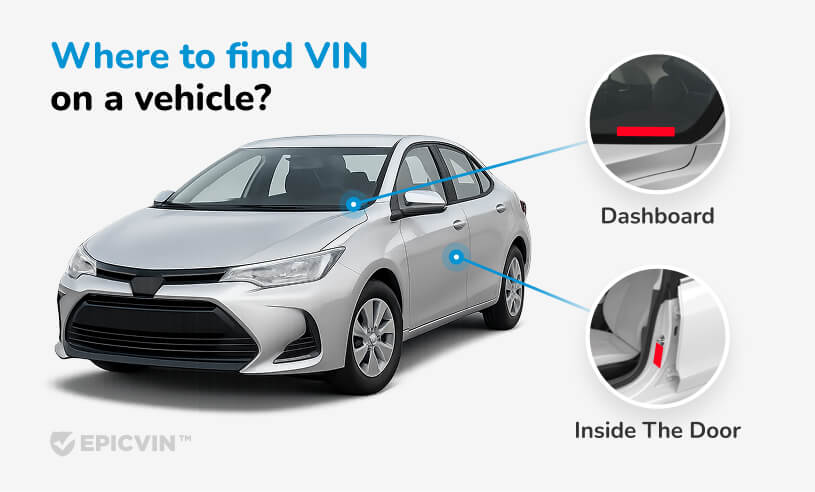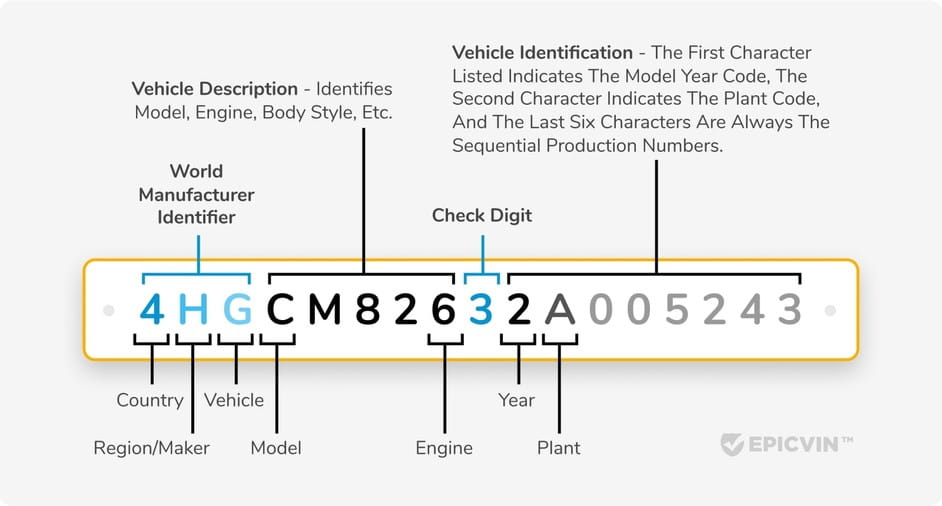
How to Read a VIN Number Like a Pro
From understanding the VIN number breakdown to uncovering a vehicle’s history,...

Free Buick VIN Decoder! 🚗 See specs, build sheet, recalls basic history—no sign-up. 🛡️✅ Need accidents, mileage, title? Upgrade in one click.
Looking for the VIN?
Here is there you’ll find it:

A Buick VIN is a unique 17-character vehicle identification number assigned to each car since 1981, standardized by the ISO Institute. Our VIN decoder helps you access vital information about any Buick model, revealing manufacturing details, engine specifications, and essential vehicle history data instantly for older cars and newer vehicles alike.
Decode any Buick VIN in four simple steps to access instant vehicle information.

Your Buick's VIN appears in multiple locations.
| Key Risk | Impact on Buyers | Mitigation Steps |
|---|---|---|
| Theft Risk | 2% of mid-size Buicks targeted yearly (estimate) | Use VIN tracking alerts and anti-theft. |
| Unrepaired Safety Recalls | ~10% of used Buicks have open recalls. | Check the NHTSA recall by VIN. |
| Depreciation Over Time | ~35% value drop within 3 years. | Buy below NADA. Consider an extended warranty. |
| Odometer Rollback Fraud | Reported in ~0.5% of listed used Buicks. | Use historical mileage VIN checks. |
| Hidden Flood or Salvage History | ~5% show hidden water damage or salvage title. | Review title records & auction photos. |
Risk Reduction: Minimize risks: Do your best to conduct a VIN check before purchase. Review the car's mileage history, liens, and accidents.
| Issue | Affected Models, Symptoms, Average Repair Cost |
|---|---|
| Intake Manifold Gasket Leak ("gloop") | Enclave 2008–2012, high mileage (~100k–150k mi); coolant loss, engine overheat. Repair ~$1,200. |
| Transmission Shudder / Slip | Encore GX 2020–2022, ~30k–60k mi; shudder on acceleration. Typical rebuild ~$2,500. |
| Dual-Clutch AWD Rear Motor Failure | Envision 2016–2019 AWD, ~80k–120k mi; loss of rear drive, error codes P0C2. Part + labor ~$3,000. |

Each character in your vehicle's unique sequence tells a specific story.
There are some other details that vehicle owners and buyers should know:
Here's how our VIN decoder interprets a sample sequence (1G4NJ52T2TC416346):
| Symbols | Sample | What It Reveals |
|---|---|---|
| 1 | 1 | The United States as the country of origin |
| 2 | G | General Motors as a manufacturer |
| 3 | 4 | Vehicle division type |
| 4-8 | NJ52T | Sedan body style, powertrain type, restraint system, model line, and trim level |
| 9 | 2 | Check digit for validation |
| 10 | T | 1996 model year |
| 11 | C | Lansing assembly location |
| 12-17 | 416346 | Individual vehicle serial number |
Year 2011
Make Buick
Model Lucerne
Fuel Type Flexible Fuel Vehicle (FFV)
Engine 3.9L V-Shaped LGD
Made in USA
Your VIN reveals detailed information through our free VIN decoder.
Tracking open recalls across 10% of used Buicks helps buyers avoid safety surprises.— Alex Black, CMO, EpicVIN
Check the dashboard through the windshield, driver's door sticker, under the hood plate, or registration documents for VIN locations.
Yes, the 11th position code "F" indicates Jinqiao, China, manufacturing in your VIN number, for instance.
Powertrain type codes in positions 4-8 indicate FlexFuel capability through specific manufacturer format data.
Enclave and LaCrosse models from 2008-2015 appear frequently, including some truck-based SUV platforms, due to transmission issues.
Use the NHTSA's official site to decode your VIN and identify any open safety recalls.
Our decoder provides free basic data; upgrade to a full report for complete accident records from insurance databases.
Code "L" typically indicates a turbocharged powertrain in VIN decoder results for newer models, another instance of detailed specifications.
Contact customer service with your VIN to obtain current warranty information and genuine parts coverage for older cars.
VINs starting with "2G" indicate Canadian market vehicles versus "1G" for U.S. market cars in this instance.
Fleet history appears in detailed vehicle history reports, not basic free decoder results for used car purchases.
Discover expert tips, news and advice on buying and maintaining used vehicles

From understanding the VIN number breakdown to uncovering a vehicle’s history,...

Here is a guide to walk you through the best ways to sell a car in 2023.

Passing a smog check starts before you even book the appointment. We’ll show y...